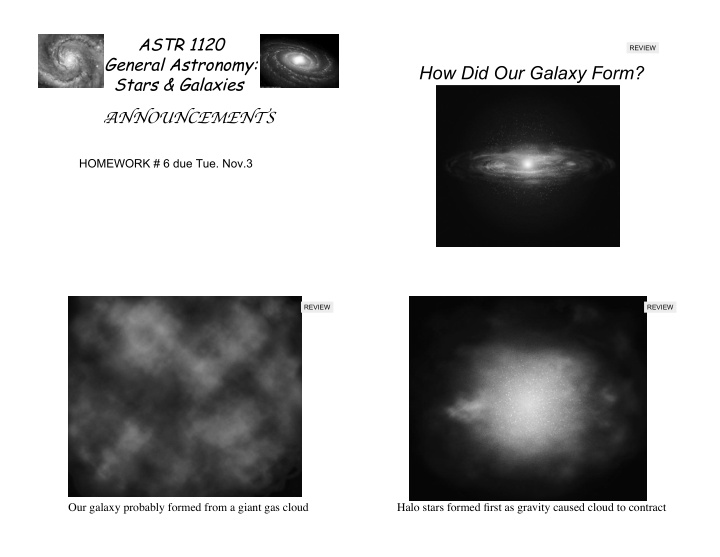



ASTR 1120 REVIEW General Astronomy: How Did Our Galaxy Form? Stars & Galaxies � NNOUNCEMENTS HOMEWORK # 6 due Tue. Nov.3 REVIEW REVIEW Our galaxy probably formed from a giant gas cloud Halo stars formed first as gravity caused cloud to contract
REVIEW REVIEW Stars continuously form in disk as galaxy grows older - Detailed studies: Halo stars formed in clumps that later stars remain in disk plane merged REVIEW Measuring Mass Using Orbital Velocities Galactic Creation Summary Rotation curve: orbital speed • What clues to our galaxy’s history do vs. halo stars hold? distance from the center – Halo stars are all old, with a smaller proportion of heavy elements than disk stars, indicating that the halo formed first • How did our galaxy form? solar system – Our galaxy formed from a few huge clouds of gas, with the halo stars forming first and the disk stars forming later, after the gas settled into a spinning disk
Reality for the Milky Way Expectation for the Milky Way • Rotation curve is flat or even rising! • There are a lot of stars • Most of the mass of in the center but also the galaxy is outside some outside the solar circle! • But few stars, little • Rotation curve should gas there… increase at first and then fall although more • DARK MATTER ! slowly than for solar probably in large system halo -- outweighs stars+gas by factor of 3 to 10 Dark matter halo for galaxies Role of dark matter on rotation profile • Dark matter extends beyond visible part of the galaxy -- mass is ~10x stars and gas! DARK MATTER • Probably not normal mass that we know of (protons, neutrons, electrons). • Most likely subatomic particles, as yet unidentified (weakly interacting massive particles – WIMPs?)
Journey to the Center of the Galaxy Infrared light from center Radio emission from center Sgr A* ~.1 ly 1000 ly of the MW center Radio emission from center Swirling gas near center Swirling gas near center Orbiting stars near center 1 Light-year
For Best Results: Use the World’s A Case for a Supermassive Black LARGEST Infrared Telescope Hole at the Galactic Center • Doppler shift measurements Enclosed mass (M o ) of spiraling stars and gas suggest 3 million M Sun black hole • Still too far out to Distance from Sgr A* (pc) exclude other Genzel 1996 The Keck Telescopes on the Big Island of Hawaii possibilities … We need to be able to see closer in to really prove there is a supermasive black hole! Stars appear to be orbiting something massive but invisible … a black hole! Orbits of stars indicate a mass of about 3-4 million M sun within 600 R Schwarzchild
X-ray flares from Sgr A* suggest that We Know Exactly Where Sgr A* tidal forces of the suspected Is and How Much it Weighs, but black hole What Does it ‘LOOK’ Like? occasionally tear apart chunks of matter about to fall in Infrared Observations Showed State of Affairs at the Galactic the Same Types of Flares Center • Stellar orbits have made our Galaxy one of the best proofs of supermassive black holes at the center of most galaxies. – Millions to billions of times the mass of our Sun. Must be created by something entirely different than a massive star supernova. • Flares are often observed in X-rays and IR – Observations of occasional flares are interpreted as the result of occasional “swallowing” of a gas clump or a star by the giant black hole.
SUMMARY/Questions? Chapter 20: Galaxies • What components make up And the Foundation of Modern Cosmology our Galaxy? – Disk: mostly flat orbits, population I stars – Bulge & Halo: spheroidal orbits, Population II stars • How did our Galaxy form? – Several VERY massive clouds colliding • What goes on in the Galaxy? – Star-Gas-Star recycling • What is most of the Galaxy mass made of? – Dark Matter • What lives at the MW Center? – Sgr A*: Supermassive Black Hole What Are The Three Major Hubble Types of Galaxies? Ultra Deep Field
Hubble Hubble Ultra Ultra Deep Deep Field Field Spiral Galaxy Hubble Hubble Ultra Ultra Deep Deep Field Field Elliptical Galaxy Elliptical Galaxy Spiral Galaxy Spiral Galaxy
Hubble Hubble Ultra Ultra Deep Deep Field Field Elliptical Galaxy Elliptical Galaxy Elliptical Galaxy Elliptical Galaxy Spiral Galaxy Irregular Galaxies Spiral Galaxy Spirals NGC 4414 ~80% of galaxies • Disks (with spiral arms) + • Spheroids (bulges+halos) M100 M101 center
HST: Center of barred spiral NGC 1365 Barred Spiral galaxies • Spiral arms emerge from central bar NGC 1365 IR view NGC 1300 Lenticulars Ellipticals (lens-shaped) ~15% of galaxies • Disks, but less gas • Round or slightly and star formation flattened • Note lack of dust & nebulae • Very little young stars • Reddish color = old stars (red giants, red main sequence)
Giant ellipticals Dwarf ellipticals • Dwarfs only contain a few • Trillions of hundred million stars stars!! • Most common type of galaxy? • Supermassive • Only know nearby ones (since faint!) black hole in the center of M87 estimated at 3 billion M Sun NGC 205 2MASS M87 Irregulars The Antennae Galaxy • Galaxies in formation? • Or transition? • Or failed? • Often LOTS of star birth
Clicker Question Clicker Question Which type of galaxy Which type of galaxy contains a high percentage of contains a high percentage of cool gas and dust? cool gas and dust? A. Spiral A. Spiral B. Elliptical B. Elliptical C. Irregular C. Irregular D. Barred spiral D. Barred spiral E. Everyone but B E. Everyone but B
Recommend
More recommend